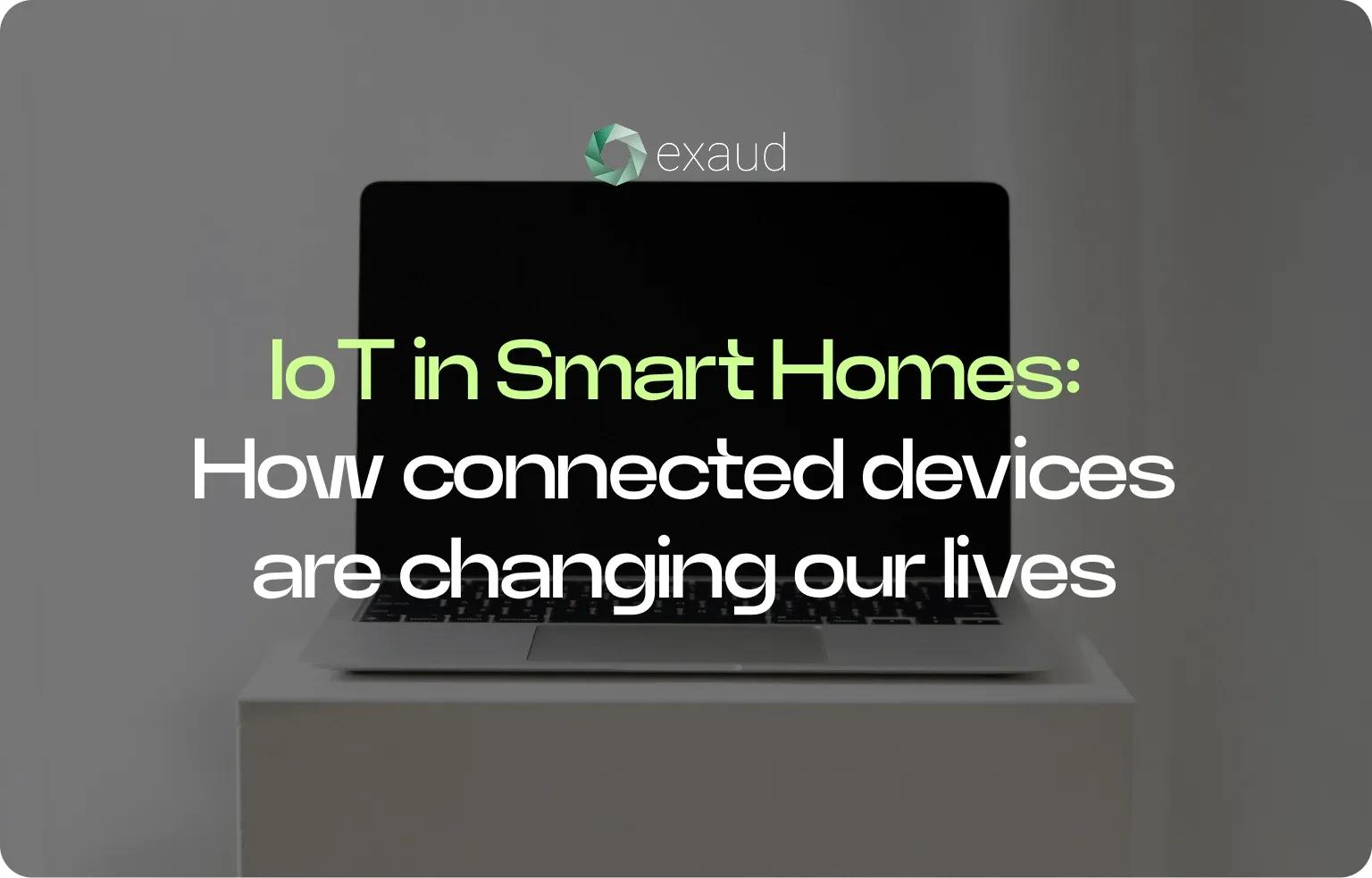Exaud Blog
Blog

IoT in Smart Homes: How connected devices are changing our lives
Discover how IoT is transforming everyday living through smart homes, improving comfort, efficiency, and security while also raising new challenges.Posted onby ExaudThe rise of the Internet of Things (IoT) is revolutionizing the way we interact with the world around us, and nowhere is this more evident than in smart homes. From smart thermostats and security cameras to voice-controlled assistants and automated lighting systems, connected devices are making our homes more efficient, comfortable, and secure.
In this article, we’ll explore how IoT in smart homes is changing the way we live, the benefits it brings, and the challenges we face as we integrate these technologies into our daily lives.
What Is IoT in Smart Homes?
IoT in smart homes refers to the integration of internet-connected devices within the home that can communicate with each other and with centralized control systems. These devices collect and exchange data to automate tasks, enhance convenience, and improve the overall living experience. From smart thermostats to advanced security cameras, IoT devices help homeowners manage their homes more efficiently and make informed decisions based on real-time data.
Smart homes utilize a variety of IoT devices that are connected through the internet and can be controlled remotely using smartphones, voice assistants (like Amazon Alexa or Google Assistant), or specialized apps. These devices are designed to perform specific tasks automatically or on-demand, such as adjusting room temperature, controlling lighting, and even managing energy usage.
Examples of smart home devices include:
Smart thermostats: Control home temperature remotely and learn your preferences over time.
Smart lights: Automatically adjust brightness or change colors based on user preferences or schedules.
Voice-controlled assistants: Such as Amazon Alexa, Google Assistant, or Apple Siri, allow for voice commands to control devices and access information.
Smart locks and security cameras: Provide enhanced security by allowing remote monitoring and control of entry points.
What makes IoT in smart homes so impactful is the ability for all of these devices to communicate with one another, creating a smart ecosystem. For example, a smart thermostat can work with a smart lock system to adjust the temperature as soon as the homeowner enters the house. Similarly, lighting can be automatically adjusted based on time of day or occupancy, contributing to energy efficiency.
Additionally, these devices allow homeowners to monitor and control their living environment from anywhere in the world. This remote control capability is one of the main driving forces behind the widespread adoption of smart home technology, as it provides convenience and peace of mind.
As the technology evolves, IoT in smart homes is set to become even more integrated, with devices communicating in real-time to enhance the way we interact with our homes. This integration has the potential to improve not only convenience but also the overall efficiency, safety, and sustainability of the home.
How IoT Works in Smart Homes
The technology behind IoT in smart homes is simple but powerful. Here's how it works:
1. Devices (Sensors, Actuators, and Controllers)
The backbone of any IoT system in smart homes consists of sensors, actuators, and controllers.
Sensors (e.g., motion detectors, temperature sensors, smart cameras) collect real-time data and send it to the system for analysis.
Actuators (e.g., smart locks, lighting, thermostats) perform actions based on the commands received, such as adjusting the temperature or turning on lights.
Controllers, such as smart hubs or apps, manage the communication between devices and users.
2. Data Processing and Cloud Integration
Once data is collected by sensors, it is processed either locally (on the device) or in the cloud. The cloud is where most of the heavy data processing happens, allowing for advanced analytics, real-time decision-making, and learning from user patterns.
For instance, a smart thermostat can adjust the temperature based on your daily habits by analyzing the data and anticipating your needs. The cloud enables devices to improve over time, providing a more personalized experience.
3. Connectivity and Communication
IoT devices in smart homes use various communication protocols to stay connected and share data:
Wi-Fi is the most common protocol for home devices, providing a stable connection for devices like smart thermostats and security cameras.
Bluetooth is often used for short-range communication between devices like smart locks and wearable health devices.
Zigbee and Z-Wave are low-power communication protocols typically used in home automation systems for lighting, security, and climate control.
4. Remote Control and Automation
IoT in smart homes allows users to control devices remotely, using smartphones or voice assistants like Amazon Alexa or Google Assistant. Through automation, tasks such as adjusting lighting, controlling appliances, or locking doors can be performed automatically or via voice command.
For example, a smart system can automatically turn off lights when you leave the room, or set the thermostat to your preferred temperature before you arrive home.
Benefits of IoT in Smart Homes
1. Increased Efficiency and Convenience
IoT enables home automation, making everyday tasks more convenient and efficient. By scheduling and automating actions like adjusting the temperature or turning on the lights, IoT devices save time and effort for homeowners. These systems learn from your habits and adapt to provide a seamless living experience.
2. Enhanced Security and Safety
Smart homes improve security through IoT-enabled devices like smart cameras, motion detectors, and smart locks. Homeowners can monitor their homes in real-time, receive alerts, and control security features remotely. For example, smart doorbells allow you to see and communicate with visitors even when you're not at home. Additionally, IoT devices can detect potential hazards, such as gas leaks, fire, or water damage, and send alerts to prevent disasters before they escalate.
3. Energy and Cost Savings
One of the major advantages of IoT in smart homes is the ability to manage energy usage more effectively. Smart thermostats, for example, adjust the temperature based on occupancy and time of day, helping to reduce heating and cooling costs. Smart lighting systems automatically adjust brightness or turn off when rooms are unoccupied, saving electricity. By optimizing energy consumption, smart homes contribute to both cost savings and environmental sustainability.
4. Better Health Monitoring
IoT devices also play an important role in health monitoring within smart homes. Wearable health trackers, such as smartwatches, can measure vital signs and track fitness levels, and the data can be integrated into a smart home ecosystem. These devices can monitor everything from heart rate and sleep patterns to step count and calories burned, providing insights into your health and enabling more personalized healthcare management.
Challenges of IoT in Smart Homes
1. Privacy and Security Concerns
With increased connectivity comes greater vulnerability to cyberattacks and data breaches. As more devices collect sensitive personal data, ensuring the security of these systems is critical. IoT devices must use strong encryption and secure authentication methods to protect user information.
2. Device Compatibility and Integration
Integrating a variety of devices from different manufacturers can be challenging. While many IoT systems are designed to work with a wide range of devices, compatibility issues may arise, particularly if different devices use incompatible communication protocols.
3. Data Overload
The massive volume of data generated by IoT devices can overwhelm users and systems. Proper data management tools are essential to filter out irrelevant data and focus on the most meaningful insights. Ensuring that users receive actionable information without being overwhelmed by excessive data is a key challenge.
The Future of IoT in Smart Homes
The future of IoT in smart homes is incredibly promising, with innovations such as 5G connectivity and edge computing poised to further enhance smart home technology. In the future, smart homes will become even more integrated and responsive, with devices communicating with each other in real-time to create a more seamless experience for the user.
Moreover, as artificial intelligence (AI) and machine learning are incorporated into smart home systems, devices will become even smarter, predicting user needs and automating tasks without the need for manual input.
IoT technology in smart homes is transforming the way we live, offering unprecedented levels of convenience, security, and energy efficiency. While challenges such as privacy concerns and device compatibility remain, the benefits far outweigh the drawbacks. As smart home devices continue to evolve and become more integrated, the future holds great potential for creating homes that are not only more connected but also more intelligent.
If you’re interested in exploring IoT solutions for smart homes, contact Exaud to discuss how we can help you integrate cutting-edge technology into your living space.
Related Posts
Subscribe for Authentic Insights & Updates
We're not here to fill your inbox with generic tech news. Our newsletter delivers genuine insights from our team, along with the latest company updates.